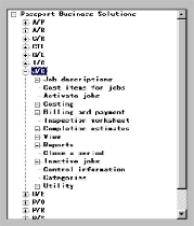
This chapter contains the following topics:
Organization of this Documentation
Starting PBS Check Reconciliation
This documentation provides the information you need to use Passport Business Solutions (PBS) Check Reconciliation.
Organization
The next chapter is a guide to daily operations. It explains how to use the Passport Business Solutions Check Reconciliation to perform various daily, weekly, and periodic tasks.
After the guide to daily operations, the next few chapters provide instructions on entering basic information to set up the module according to your needs and to prepare you for daily operation.
The remainder of the guide contains chapters that you use most frequently. They describe how to use the Passport Business Solutions Check Reconciliation on a daily basis.
The last few chapters describe selections that you might use periodically, including such selections as compressing cleared entries.
You can obtain additional information from the System User documentation, which contains chapters that describe features common to all Passport Business Solutions modules.
| • | Topics covered in the System User documentation include: |
| • | General data entry rules |
| • | Help and Lookups |
| • | Switching companies |
| • | Defining menu selections |
| • | Using printers for reports and forms |
| • | Glossary of terms |
Each chapter of this documentation provides instructions on how to use a particular selection of your software.
The instructions include examples. In fact, you can go through the documentation and enter the examples shown in each chapter. This demonstrates the capabilities of your new software.
If you enter the examples, you initialize the data before you begin entering your actual business information. When you initialize data, you clear out all information entered in that file/table. The initialization procedure is provided in the PBS Administration documentation. After initialization, you restart with this chapter and enter your actual business information.
Graphical Mode
Help is accessed via the <Ctrl>+<F1> key.
Character Mode
You can press the <F8> key at any time for on-line help about a task or selection you are currently using.
If a data window is displayed instead of help, you must press <F8> a second time to retrieve help.
A menu is a list of things from which something can be selected.
Selecting items from a menu on a computer is the way you tell your computer what you want to do.
The Windows version of PBS can have three different menu types. They are the Tree-view, Windows and Menu-bar types.
The SCO Open Server and Linux versions only provide the Menu-bar menu.
The following screen is an example of the Tree-view menu.

The “+” corresponds to expandable menu sections. One click will open the menu selection for the application or the sub-menu of a particular menu entry. Clicking on the “-” closes the menu item. Viewing application menus will cause a vertical slider bar to display: and sometimes depending on size and proportions of the screen and associate font, the slider bar as well. These sliders are mouse enabled.
In addition to the mouse-based menu operation, you can use the keyboard to navigate the tree-view menu. The home, end, page-up, page-down and arrow keys provide a quick and easy method of maneuvering around the menu.
To select the menu program use the Enter key or click on the menu line with the mouse.
The remainder of this section describes the functions of the Menu-bar. To navigate horizontally between individual modules use your keyboard’s left and right arrow keys. Up to ten modules and your Passport Business Solutions System Manager may be displayed on the menu bar. If you are using more than ten modules, a More function is added to the menu bar. To access your additional modules, highlight More and press your <Enter> key.
To navigate vertically within a module you have two choices. You may use the up and down arrow keys on your keyboard or you may type the first letter of a displayed menu item. If more than one menu item starts with the same letter, pressing the letter again will position your cursor over the next menu item starting with that letter.
To start your PBS software, select one of the following options. If you are unsure how to proceed, please contact your supplier.
For Windows
Start->Programs->Passport Business Solutions->PBS
For UNIX/Linux
Ensure you are logged in as a user authorized to use PBS software. Refer to the PBS Administration documentation for more information.
Type the following:
cd /usr/pbs
or replace “/usr/pbs” with the name of your PBS top-level directory.
Then type the following:
pbs
Then when the master menu appears, select the module you wish to use from the master menu.
If you have set up your software to process information for more than one company (refer to Define Multiple Companies in the PBS Administration documentation), you will be prompted to enter the Company-ID.
You are prompted to enter your initials.
You will be prompted to enter your password. For security, the characters you type will not display on the screen. A user may reset his or her password during login to PBS.
For the initial setup of users and passwords, refer to PBS Users chapter in the PBS Administration documentation.
To exit a Passport module, press <Esc> from the main menu. To exit a sub-menu, press <Esc> to return to a main menu. You can also exit out of the Windows menu by clicking on the Exit button.
If you exit PBS improperly, it may cause a data loss.